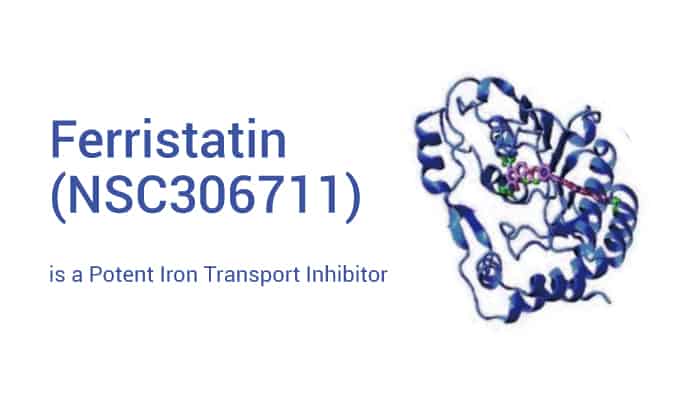Iron is an essential nutrient required for DNA synthesis, energy production, and normal cellular growth. Meanwhile, Iron circulates in the plasma bound to transferrin (Tf). Particularly, Most cells express Tf receptors on their surface to bind and internalize Tf by receptor-mediated endocytosis. Importantly, Study shows that alterations in the expression/function of iron transport proteins will induce some clinical disorders, such as iron-deficiency anemia, anemia of inflammation, hereditary hemochromatosis, and so on.
Ferristatin (NSC306711) is a potent iron transport inhibitor.

Ferristatin blocks Tf-mediated iron uptake with IC50 of 20 μM. Besides, Ferristatin also is a polyaromatic compound that contains copper. Meanwhile, Ferristatin (1, 10, 20, 50 µM; 4h) inhibits the uptake of 125I-labeled and 55Fe-labeled transferrin (Tf) in a dose-dependent manner in HeLa cells. Moreover, Ferristatin (0-50 µM; 0-360 min) decreases the expression of TfR1 protein in a dose- and time-dependent manner in HeLa cells. In addition, Ferristatin-induced Tf receptor degradation is clathrin and dynamin independent but is sensitive to cholesterol depletion. Obviously, Ferristatin targets this pathway by inducing the internalization and subsequent degradation of cell-surface Tf receptors.
Ferristatin also shows antiviral potency. Ferristatin binds to the DENV MTase, methyltransferase (MTase) is an essential enzyme that sequentially methylates the N7 and 2’-O positions of the viral RNA cap, using S-adenosyl-L-methionine (SAM) as a methyl donor. Besides, Ferristatin inhibits flavivirus MTases activity with N7 IC50s of 5.3, 36, 1.2 µM, 2’-O IC50s of 6.9, 4.7, 1.1 µM for DENV2, DENV3, YFV, respectively. Furthermore, Ferristatin (0-3 µM; 42 h) inhibits cell viability and reduces the WNV (West Nile virus) titer in a dose-dependent manner with an EC50 value of 1.0 µM.
All in all, Ferristatin is a potent iron transport inhibitor and shows antiviral potency and anti-MTase activity.
Reference:
[1] Horonchik L,et al. Chem Biol. 2008 Jul 21;15(7):647-53.
[2] Brecher M, et al. PLoS One. 2015 Jun 22;10(6):e0130062.